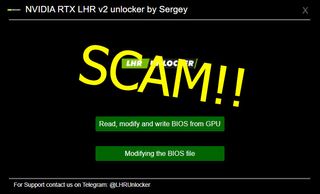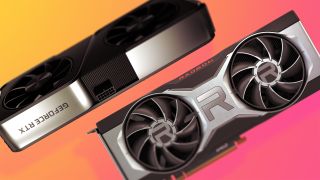That tool that was supposed to unlock the full hash rate of Nvidia LHR cards is actually malware
It's not even that surprising.

It turns out that miners looking to extract the maximum hash rates from Nvidia’s Lite Hash Rate RTX 30 series cards have been fooled. The tool does not remove the hash rate limiter, but instead installs malware.
As we reported just yesterday, it appeared as though an enterprising modder had managed to completely bypass the crypto mining restrictions Nvidia places on several of its RTX 30 series graphics cards. The user, ‘Sergey’ released a BIOS modification tool on GitHub that supposedly bypassed the checks that Nvidia has in place to lower mining performance when Ethash mining is detected.
If a user downloaded and ran the 'LHRUnlocker Install.msi', it simply didn't do what it claimed to do, instead infecting powershell.exe, which is a Windows service with malware. It’s also unknown what impact the malware has. Speculation includes everything from keylogging to attempting to set up a botnet for mining.
Several users proceeded to post questions Sergey’s own GitHub page which went unasnswered. The page has since been taken down.

How to buy a graphics card: tips on buying a graphics card in the barren silicon landscape that is 2022
The exposure of this tool as malware means that Nvidia’s LHR limiter remains intact. While legitimate (in a vague sense of the word) methods have managed to bypass the limiter to some extent, LHR cards still cannot match the Ethash rate of their FHR counterparts. Nvidia deserves credit for at least attempting to reduce the appeal of many of its gaming GPUs to miners.
So, if you’re downloaded the tool and you’re waiting for that ‘special driver’, please delete anything and everything from this scammer. It serves as a reminder that crypto remains in the equivalent of the wild west days. A general rule, if it’s too good to be true, it is.
The biggest gaming news, reviews and hardware deals
Keep up to date with the most important stories and the best deals, as picked by the PC Gamer team.

Chris' gaming experiences go back to the mid-nineties when he conned his parents into buying an 'educational PC' that was conveniently overpowered to play Doom and Tie Fighter. He developed a love of extreme overclocking that destroyed his savings despite the cheaper hardware on offer via his job at a PC store. To afford more LN2 he began moonlighting as a reviewer for VR-Zone before jumping the fence to work for MSI Australia. Since then, he's gone back to journalism, enthusiastically reviewing the latest and greatest components for PC & Tech Authority, PC Powerplay and currently Australian Personal Computer magazine and PC Gamer. Chris still puts far too many hours into Borderlands 3, always striving to become a more efficient killer.
Most Popular






